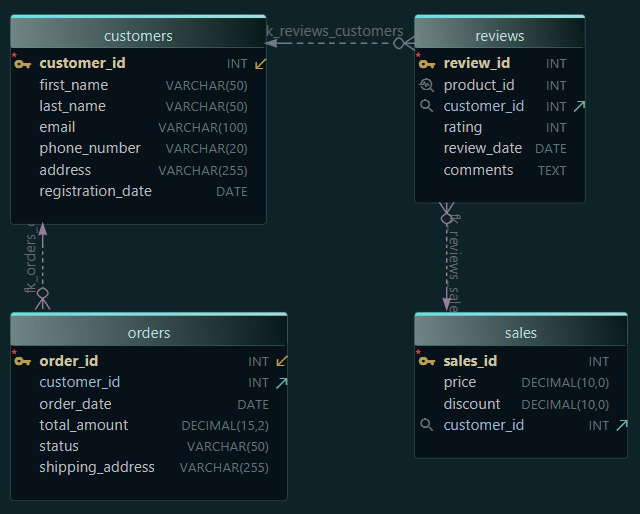SQL HAVING Clause Explained with Examples
Structured Query Language (SQL) is a potent tool for handling relational databases. One of its vital features is the HAVING clause, which allows us to filter results after performing an aggregate function. This article delves deep into the world of the HAVING clause, distinguishing it from WHERE, and showcasing its applications with various aggregate functions.
1. Introduction to SQL HAVING CLAUSE
The HAVING clause is used in SQL to filter the results of aggregate functions like SUM, AVG, MAX, etc. Unlike the WHERE clause, which filters rows before aggregation, HAVING filters after the aggregation is completed.
Syntax:
SELECT column1, aggregate_function(column2)
FROM table_name
GROUP BY column1
HAVING aggregate_function(column2) condition;
2. Differentiate between SQL HAVING vs WHERE
| Attribute | SQL HAVING | SQL WHERE |
|---|---|---|
| Purpose | Filters aggregated data | Filters individual rows |
| Use with | Typically with GROUP BY | Used without GROUP BY (though can be used with) |
| Position in SQL | Comes after GROUP BY | Comes before GROUP BY |
3. Using Aggregate Functions with HAVING
a. Using SUM Function
Example: Let's consider a sample table Orders:
| OrderID | ProductName | Quantity |
|---|---|---|
| 1 | Apples | 50 |
| 2 | Bananas | 30 |
| 3 | Apples | 20 |
If we want to find products that have a total quantity greater than 40:
SELECT ProductName, SUM(Quantity) as TotalQuantity
FROM Orders
GROUP BY ProductName
HAVING SUM(Quantity) > 40;
Result:
| ProductName | TotalQuantity |
|---|---|
| Apples | 70 |
b. Using MIN Function
Finding products with the minimum order quantity less than 25:
SELECT ProductName, MIN(Quantity) as MinimumQuantity
FROM Orders
GROUP BY ProductName
HAVING MIN(Quantity) < 25;
Result:
| ProductName | MinimumQuantity |
|---|---|
| (No results matching the criteria) |
c. Using AVG Function
Finding products with an average quantity below 30:
SELECT ProductName, AVG(Quantity) as AverageQuantity
FROM Orders
GROUP BY ProductName
HAVING AVG(Quantity) < 30;
Result:
| ProductName | AverageQuantity |
|---|---|
| Bananas | 30 |
d. Using MAX Function
Finding products with a maximum order quantity greater than 60:
SELECT ProductName, MAX(Quantity) as MaximumQuantity
FROM Orders
GROUP BY ProductName
HAVING MAX(Quantity) > 60;
Result:
| ProductName | MaximumQuantity |
|---|---|
| (No results matching the criteria) |
4. HAVING with GROUP BY and ORDER BY Clauses
a. Filtering Rows Using WHERE and HAVING
Filtering products with a total quantity greater than 20 and grouping those with a total quantity greater than 40:
SELECT ProductName, SUM(Quantity) as TotalQuantity
FROM Orders
WHERE Quantity > 20
GROUP BY ProductName
HAVING SUM(Quantity) > 40;
b. Filtering Rows on Multiple Values Using HAVING
Finding products with a total quantity between 30 and 70:
SELECT ProductName, SUM(Quantity) as TotalQuantity
FROM Orders
GROUP BY ProductName
HAVING SUM(Quantity) BETWEEN 30 AND 70;
Result:
| ProductName | TotalQuantity |
|---|---|
| Apples | 70 |
| Bananas | 30 |
c. HAVING with GROUP BY Clause
Grouping by product name and filtering products with a total quantity greater than 40:
SELECT ProductName, SUM(Quantity) as TotalQuantity
FROM Orders
GROUP BY ProductName
HAVING SUM(Quantity) > 40;
Result:
| ProductName | TotalQuantity |
|---|---|
| Apples | 70 |
d. HAVING with ORDER BY Clause
Ordering the grouped results by total quantity in descending order:
SELECT ProductName, SUM(Quantity) as TotalQuantity
FROM Orders
GROUP BY ProductName
HAVING SUM(Quantity) > 40
ORDER BY TotalQuantity DESC;
Result:
| ProductName | TotalQuantity |
|---|---|
| Apples | 70 |
e. HAVING Clause with COUNT() Function
Finding products that have been ordered more than once:
SELECT ProductName, COUNT(OrderID) as NumberOfOrders
FROM Orders
GROUP BY ProductName
HAVING COUNT(OrderID) > 1;
Result:
| ProductName | NumberOfOrders |
|---|---|
| Apples | 2 |
5. Common Mistakes & FAQs
Mistakes
-
Using
HAVINGwithoutGROUP BY:- The
HAVINGclause is typically used to filter aggregated results. Without theGROUP BYclause, there's often little reason to useHAVING. While some databases might allow this, it's a misuse of the clause's intent.
- The
-
Confusing the order of SQL operations:
- It's crucial to remember the sequence:
FROM->WHERE->GROUP BY->HAVING->SELECT->ORDER BY. Trying to filter aggregated results usingWHEREinstead ofHAVINGwill throw an error.
- It's crucial to remember the sequence:
-
Using non-aggregated columns in the HAVING clause without them being in the GROUP BY clause:
- This is a common error. If you're trying to use a column in the
HAVINGclause that's not part of an aggregate function, it must also appear in theGROUP BYclause.
- This is a common error. If you're trying to use a column in the
-
Over-relying on HAVING:
- While
HAVINGis powerful, it shouldn't replaceWHEREfor basic row-level filtering. UseWHEREwherever possible to reduce the size of the result set early in the processing.
- While
FAQs
-
Can we use
WHEREandHAVINGtogether?- Yes, and it's common to do so.
WHEREfilters rows before aggregation, whileHAVINGfilters after aggregation.
- Yes, and it's common to do so.
-
Why is my
HAVINGclause not recognizing a column that's in mySELECTstatement?- This typically occurs when trying to filter on a column that's not a part of an aggregate function or the
GROUP BYclause. If you're grouping results, every column in theSELECTthat's not part of an aggregate function needs to be included in theGROUP BYclause.
- This typically occurs when trying to filter on a column that's not a part of an aggregate function or the
-
Can I use aggregate functions in the
WHEREclause instead ofHAVING?- No, aggregate functions cannot be used in the
WHEREclause. If you need to filter based on the result of an aggregate function, you should use theHAVINGclause.
- No, aggregate functions cannot be used in the
-
Is
HAVINGexclusive to SQL?- While the concept of filtering on aggregated data is not unique to SQL, the
HAVINGclause, as described in this article, is SQL-specific.
- While the concept of filtering on aggregated data is not unique to SQL, the
-
Can I use
HAVINGwithout any aggregate functions?- Technically, yes, some databases might allow this, but it's not standard practice. The purpose of
HAVINGis to filter aggregated results, so using it without aggregations can be confusing and misrepresents its intent.
- Technically, yes, some databases might allow this, but it's not standard practice. The purpose of
6. Practice Questions
- Write a SQL statement to find products that have an average quantity below 30.
- Find the minimum order quantity for each product, but only display products with a minimum order of more than 20.
- How would you list products that have been ordered more than 3 times, based on the Orders table?
By integrating comprehensive explanations with practical examples, we aim to offer an in-depth understanding of the SQL HAVING clause. Remember, practice is key. Experiment with different scenarios and datasets to refine your SQL skills.
Happy Querying







